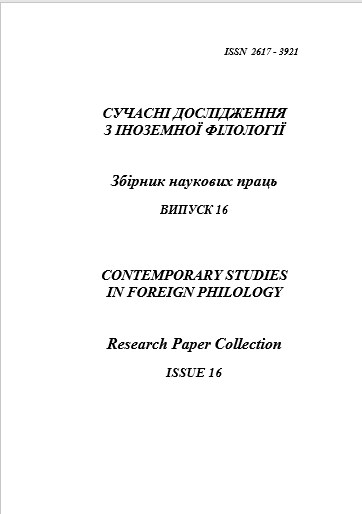Miscommunication across cultures: topical issues
DOI:
https://doi.org/10.24144/2617-3921.2018.16.%25pАнотація
Анотація. Стаття торкається актуальних проблем, пов’язаних із різними видами неправильного спілкування, яке за певних умов виникає в процесі або як результат неуспішної міжмовної та міжкультурної комунікації. Значна увага приділяється теоретичним питанням розуміння сутності міжкультурного спілкування, його специфіці, основним факторам виникнення непорозумінь, в основі яких лежать як лінгвальні, так і екстралінгвальні чинники. Предметом розгляду виступають вербальна та невербальна комунікація, де часто виникають неправильні тлумачення слів, їхніх значень, стійких словосполучень, жестів, вимови, міміки, поведінки тощо. Усе це в кінцевому рахунку призводить до неправильного спілкування, яке негативно позначається на повсякденному житті та діяльності людей, їхньому сприйнятті об’єктивної дійсності, вмінні співпрацювати й налагоджувати різного роду контакти як у своєму соціумі, так і в межах інших суспільних об’єднань, середовищ, суспільства в цілому. Наслідками неправильної міжкультурної та міжмовної комунікації можуть бути різного роду суперечки, конфлікти, протистояння, непорозуміння, насильство, воєнні дії, злочини і т.п.
Ключові слова: неправильне спілкування, міжмовна комунікація, міжкультурна комунікація, непорозуміння, лінгвальні та екстралінгвальні чинники, вербальна і невербальна комунікація.
Abstract. The present paper touches upon topical issues connected with miscommunication of different types, which appears due to certain reasons in the process or as a result of unsuccessful cross-language and cross-cultural communication. Much attention is paid to theoretical considerations about the essence of cross-cultural communication, its specificity, main factors of misunderstandings based on lingual and extralingual reasons. The paper also deals with verbal and nonverbal communication where often incorrect word meaning usages as well as improper gesture, mimics and behaviour interpretations occur. Even in languages and cultures which share many features, there are connotations and nuances which may be easily missed or misunderstood. Moreover, we see cultures based on much different foundations and we see languages that differ in all elements of language design. As a result, there is constant possibility of major miscommunications which negatively influences everyday lives and activities of people, their objective reality perception, ability to co-operate and establish various contacts within social settings, environments and societies. Cultural norms, values and patterns of behaviour may be interpreted very differently among groups of people. Nonverbal communication can be even more difficult to interpret. Furthermore, what is funny to one culture, may be offensive to another one. Something that is funny to both cultures may still cause difficulties if delivered in a formal environment, especially if one culture considers it to be an inappropriate setting. What may be perfectly fine with one group of people, may not be so fine with others who belong to the same group and may have a different opinion due to diversity issues. Not everyone who belongs to a particular group necessarily shares all the attitudes as well as behaviours of that group. Miscommunication across languages and cultures may result in disputes, conflicts, oppositions, misunderstandings, violence, military operations, crimes, etc. Language and culture study in general are the basic methods for overcoming cross-cultural miscommunications and misunderstandings.
Keywords: miscommunication, cross-language communication, cross-cultural communication, misunderstanding, lingual and extralingual factors, verbal and nonverbal communication.
##submission.downloads##
Номер
Розділ
Ліцензія
Автори, які публікуються у цьому журналі, погоджуються з наступними умовами:
- Автори залишають за собою право на авторство своєї роботи та передають журналу право першої публікації цієї роботи на умовах ліцензії Creative Commons Attribution License, котра дозволяє іншим особам вільно розповсюджувати опубліковану роботу з обов'язковим посиланням на авторів оригінальної роботи та першу публікацію роботи у цьому журналі.
- Автори мають право укладати самостійні додаткові угоди щодо неексклюзивного розповсюдження роботи у тому вигляді, в якому вона була опублікована цим журналом (наприклад, розміщувати роботу в електронному сховищі установи або публікувати у складі монографії), за умови збереження посилання на першу публікацію роботи у цьому журналі.
- Політика журналу дозволяє і заохочує розміщення авторами в мережі Інтернет (наприклад, у сховищах установ або на особистих веб-сайтах) рукопису роботи, як до подання цього рукопису до редакції, так і під час його редакційного опрацювання, оскільки це сприяє виникненню продуктивної наукової дискусії та позитивно позначається на оперативності та динаміці цитування опублікованої роботи (див. The Effect of Open Access).

